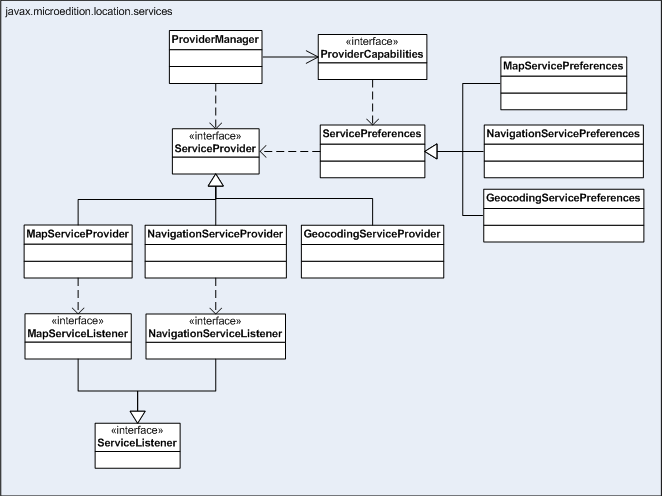|
||||||||||
| PREV PACKAGE NEXT PACKAGE | FRAMES NO FRAMES | |||||||||
See:
Description
| Interface Summary | |
|---|---|
| GeocodingServiceProvider | This interface collects the services that geocoding service providers offer. |
| Map | This class represents a dynamic map generated by a map service provider. |
| MapServiceListener | This interface provides a callback mechanism for the map service providers to send information about the service request to applications. |
| MapServiceProvider | This interface collects the services that map providers offer. |
| NavigationServiceListener | This interface provides a callback mechanism for navigation service providers to announce their state and results to applications. |
| NavigationServiceProvider | This interface collects the services that navigation providers offer. |
| ServiceListener | This is a super interface for all listeners related to different services. |
| ServiceProvider | This is a super interface for all service providers defined in this API. |
| Class Summary | |
|---|---|
| GeocodingServicePreferences | This class captures the preferences related to geocoding service provider. |
| MapServicePreferences | This class captures the preferences related to map service provider. |
| NavigationInstruction | This class collects the instructions for navigating a route segment. |
| NavigationServicePreferences | This class encapsulates the preferences that are used when requesting routing services from a navigation service provider. |
| ProviderCapabilities | This class collects the information about the capabilities of a service provider. |
| ProviderManager | This class is the starting point for using service provider interfaces in Location API 2.0. |
| Route | This class represents a route. |
| RouteSegment | This class represents a segment of a route. |
| ServicePreferences | This class is a superclass for service preferences. |
| Exception Summary | |
|---|---|
| ServiceException | The ServiceException is thrown when an error related
to handling service provider requests has occurred. |
Contains the classes and interfaces related to location based services.
Location API 2.0 extends version 1.0 also with a general client interfaces to different location based services. Through these interfaces the applications are able to use services that are provider by the terminal implementation. Examples of these services are map, navigation and geocoding services.
The geocoding service allows applications to convert street addresses into coordinates and vice versa. With map service applications are able to display maps and selected location or landmarks to the user or select an area, landmark or a location from a map. The navigation service offers applications the possibility to request navigation related services from the service provider.
This specification defines client interfaces that applications can use to access location based services provided by the terminal implementation. This specification does not define a mechanism to include dynamic service provider implementations to the ternminal implementations. They are out of scope for JSR 293. More information about service provider implementations and their installation can be found from Appendix D.
The mechanism how applications use services may be categorized into two different types. These types are based on the level of interaction applications want to have with the service provider. In this specification the following service types are used.
MapServiceProvider.displayMap method.NavigationServiceProvider.getRoute
and then draws the returned route to the screen itself.In this API the service provider interfaces are managed through
ProviderManager class. This class offers static methods to find and select
service providers. Information about the service provider is stored in
ProviderCapabilities class. With this information about the capabilities of the
service provider, applications are able to select the right service provider that meets
their requirements.
This API provides a common ServiceProvider interface that acts as a super
interface for all different service interfaces and collects the methods common to all
providers. This API also defines detailed service interfaces for geocoding, map and
navigation services. Most service provider interface, including the super interface,
have a corresponding listener to allow applications to receive information about the state
of the service. The following class diagram depicts the whole service provider
architecture.

|
||||||||||
| PREV PACKAGE NEXT PACKAGE | FRAMES NO FRAMES | |||||||||